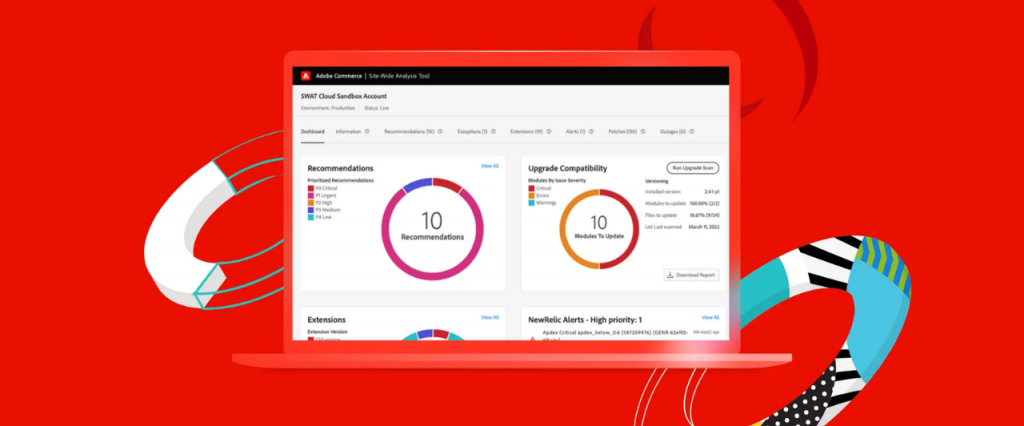When you’re deciding whether to go with an eCommerce platform like Adobe’s, you’ll want to know the benefits and drawbacks of each. This article will focus on the cost, flexibility, customization and integration with CRM. The pros and cons of using a platform will depend on your specific needs and requirements. Keep reading to learn more. You’ll find that there are several advantages to using Adobe Commerce.
 Cost
Cost
The cost of Adobe Commerce depends on its level of customization and the number of sites
it is used for. Most people using Adobe Commerce are operating multiple websites and
companies that sell to different locations throughout the world. These businesses typically
conduct billions of dollars in annual sales, and so their costs will be higher than those of a
single site. If you are considering buying Adobe Commerce, you should know that it is often
bundled with other Adobe products. You will need to pay for system upgrades every quarter.
Adobe Commerce is more expensive than Magento Community, which is free to use.
However, you can benefit from the same 24/7 technical support, as well as the full set of
functionalities. The cost of Adobe Commerce will be in the region of $22,000 a year for a
license, which will increase with your store’s revenue. Adobe Commerce is available as an
on-premise or cloud-hosted solution. Both options use the same codebase. In the cloud,
certain platform updates are automatically applied.
Compared to an on-premise data warehouse, Adobe Commerce Cloud is hosted in the
cloud. It is accessible anywhere with an internet connection. It also ensures data security
and keeps your account clutter-free. The software also comes with a complete reporting and
visualization tool. The analytics tool will give you insight into what’s working and what’s not.
You can make changes based on this information to improve your store. Adobe Commerce
Cloud can help you track everything from product sales to customer satisfaction.
For stores making less than $1 million a year, the cost is as low as $22,000 a year. For store
owners earning more than $1 million a year, however, Adobe Commerce is the better choice.
However, it can be a bit more expensive than Magento CE. If you don’t have in-house
expertise or want to save money, Magento CE is the best option for your business.
 Flexibility
Flexibility
The flexibility of Adobe Commerce comes with a cost, however. While the Starter plan is
ideal for small retailers, the Pro plan is suited for large enterprises. Large enterprises require
higher levels of product architecture and customized infrastructure. Additionally, certain
features require the use of third-party tools, such as Adobe Magento integration. Despite
these drawbacks, many organizations find Adobe Commerce well-suited to their needs.
However, before selecting this platform, be sure to check out its capabilities.
While many eCommerce platforms are designed to cater to consumer demand, Adobe’s
platform is also designed for B2B commerce. The B2B model requires different selling
motions, infrastructure, and processes. However, these companies can achieve greater
revenue from this new type of commerce. This eBook will highlight three companies that
made the move to a hybrid eCommerce model using Adobe Commerce. While there is no
single solution that works for every business, these three companies demonstrate the
flexibility of the platform in real-world situations.
While Shopify B2B is capable of satisfying simple use cases, Adobe Commerce is more
suited for businesses that need to support a variety of buyers and complex organizations.
Many B2B buyers are complex organizations that require customization. Because Adobe
Commerce is cloud-based, the flexibility and agility of the platform will not be limited to a
single business model. Additionally, it supports progressive web applications, which is an
important feature for B2B sites.
Lastly, the flexibility of Adobe Commerce extends to its content management capabilities. By
leveraging the Content Staging feature, store owners can create content updates and
preview the results of these updates. With this feature, store owners can also schedule tasks
for future changes and updates. Content Staging is essential for any ecommerce business
because it allows a site to automatically update itself to reflect changes in consumer
behavior. This feature is particularly helpful when it comes to enhancing content quality.

 Customization
Customization
When you’re considering a new ecommerce platform, you may be wondering whether you
should opt for Adobe Commerce or another alternative. Both products offer robust features
for enterprises and scalability is a major benefit. However, you should know that if you’re not
tech-savvy, you might need an in-house developer to customize your site. However, with so
many options, there’s nothing to stop you from implementing both.
While both Magento and Adobe Commerce offer open-source options, the latter can be
expensive. The enterprise version, however, has a range of customizations and offers a
variety of extensions and integrations. For those who don’t have extensive technical skills,
Adobe Commerce is not a practical solution. There are some limitations with the software,
but overall, there’s no need to worry about them. The platform’s extensive knowledge base
and free extensions make it a good choice for many types of businesses.
Although it has an extensive feature set, Shopify’s platform is still a little behind its
competition in terms of SEO and content marketing. It can also be difficult to customize your
checkout process. Lastly, some features of the ecommerce platform require you to subscribe
to paid apps. While Shopify might seem to be the most affordable option, monthly app costs
can quickly add up. If you don’t plan on relying on these features, you should probably
reconsider.
While it’s based on Magento code, Adobe is no longer open-source. The development
community of both platforms is a precious source of innovation in the ecommerce industry,
so there’s no reason that Adobe’s code shouldn’t benefit from that innovation.
 Integration with CRM
Integration with CRM
In the context of delivering the best possible customer experience, integrating data from your
CRM with your web store is key. This data cannot be isolated in silos, so the integration
between CRM and Adobe commerce helps you connect all of your data in real time. To get
started, contact StarfishETL today for a free demo. You can also request a quote for your
integration project. Let us walk you through the steps of the integration process.
The robust backend tools provided by Adobe Commerce help customer care representatives
easily fetch order details and make modifications. This enables the business to ensure that
every customer gets the best possible experience while shopping online. In addition to this,
the admin can grant permissions to individual customer care representatives to manage
orders. In this way, a single integrated platform can boost sales and improve customer
satisfaction.
With an integrated CRM system, Magento (formerly known as Shopify) websites can make
use of Metrilo’s data to improve customer acquisition, improve customer experience, and
track order history. With this integration, the eCommerce website can make credible data-
driven decisions in real time, and maximize customer satisfaction. And, in addition to
enhancing the customer experience, Magento(Adobe commerce) and Metrilo integration can
streamline the entire sales cycle.
Personalization is essential to attracting website visitors and converting them into buyers.
Adobe Commerce excels at delivering highly personalized CX. It uses analytics to display
relevant content, promotions, and pricing to specific customers. The tool can also use data
from CRMs to make recommendations. The product recommendation feature in Adobe
Commerce powers over 300 websites. If you are interested in integrating CRM and Adobe
Experience Cloud together, it’s definitely worth a look.
 AI
AI
There are several major advantages of using Adobe Commerce for your business, including
a powerful cloud-based e-commerce system and the ability to integrate it with other Adobe
tools. For example, you can link your store to the Marketing Cloud and Analytics Cloud, and
the integration with Amazon marketplace is a powerful way to track key business metrics.
But, the price is a major downside. Adobe Commerce is best for large businesses that have
many stores in different countries and do both B2C and B2B sales.
While Adobe Commerce is a powerful solution for a small business, it’s not for everyone.
While it offers a rich set of features, it’s also complex enough to require an expert team to
maintain. If you’re looking for a platform that allows you to easily configure and change your
business’s functionality, it’s probably not the best option for you. However, if you’re building a
website from scratch, this platform will allow you to do it with little hassle.
As a slick and customizable e-commerce platform, Adobe Commerce has a high price tag,
especially for beginners. As an enterprise, you’ll have to pay a minimum license fee, which
can be prohibitive if you’re only making a few sales a month. Alternatively, you can choose a
free platform instead. This way, you’ll have more flexibility when it comes to adding new
features.


